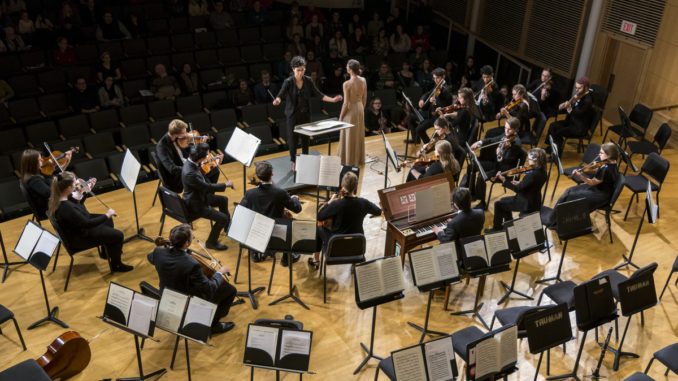
Truman State University’s Orchestra has seen many changes in its ability to practice and perform this semester, with COVID-19 concerns causing alterations in how it provides musical ensembles to the student body and their families.
Despite the difficulties COVID precautions can create, both students and faculty are satisfied with the results of practices and their first performance, conducted Oct. 3.
“I think all things considered it went pretty well,” principal cello performer Sam Tillman said. “Doing musical ensembles this year has been unique, but for the orchestra we have been able to adjust fairly easily.”
Tillman was one of 44 members of the orchestra ensemble that were present in the first performance. However, because of social distancing recommendations, only 22-23 musicians were performing at one time. This restriction caused various alterations to the performance, including an intermission to allow students to come on and off stage and talk about the piece about to be performed.
Sam McClure, orchestra conductor and director of orchestral activities, said the limit on performers also meant a change in musical pieces used, focusing on works that required fewer musicians.
Other changes during the concert included no longer sharing music stands and being more spread apart than usual.
“There’s a modest challenge when people are spaced further apart, the more you are spaced out the harder it is to time playing together,” Tillman said.
View the entire University Orchestra Concert below.
Video provided by Department of Music
Another change was the use of masks during the performance, which was not difficult for string musicians. However, this did require woodwind and brass performers to remove masks during their performances.
These changes in on-stage conduct were not noted as being disruptive to the Orchestra’s actual performance, and future performances will continue as planned without any further changes.
“The students did a great job overall this performance, and I think we are all very excited for the next concert on Nov. 14,” McClure said.
The biggest adjustment for the department this semester was the exclusively digital performances whereas in previous semesters Orchestra performances had a live audience as well as a digital option. McClure said over 200 viewers were able to watch the University Orchestra perform this month, not including multiple viewers on a single screen.
Even though the students performing were only able to see their peers in the stands, not having a normal audience would not have as large an effect on the performer’s growth as one might think.
“The audience pressure isn’t as much as the pressure of the performance,” professor Elaine AuBuchon said. “Most of the students here have been playing since they were 6th graders and have lots of experience performing in front of a crowd already.”
AuBuchon was one of two faculty members featured in the Orchestra for the October performance, she played the oboe alongside students.
With every performance recorded virtually, COVID-19 has caused the music department to make changes not only to how it performs for an online audience, but also practices for upcoming concerts.
“One of the biggest differences for us is that we are trying to find ways to perform together without putting each other at risk,” AuBuchon said.
Practice halls on campus have started having time limits for use to allow air to cycle within the room. Having less space to practice and social distance also means lessons are performed remotely. Accompanying faculty have also been recording practices digitally to benefit students. Recordings of the actual performance are currently in the process of being upgraded by the department in order to give viewers a better audio and visual experience, McClure said.
Outside the performances, both faculty and students have made notable efforts for the socially distant semester. McClure said he was proud that there have been no COVID-19 cases among performers this semester, and that there have been only three absences at rehearsals, a sign of dedication among students.
For musicians who have dedicated their Truman experience to the fine art, the joy comes from being able to perform their work for others. Whether the audience is digital or in-person, Truman’s orchestra ensemble shares a passion that COVID-19 cannot stop.
“It was nice to be able to perform,” Tillman said. “I’m glad we were able to play and were able to reach several hundred viewers, even if they were online.”
